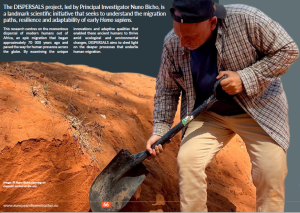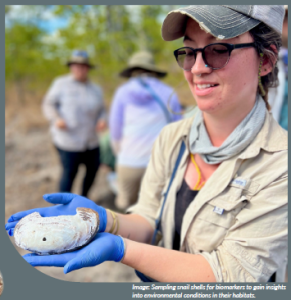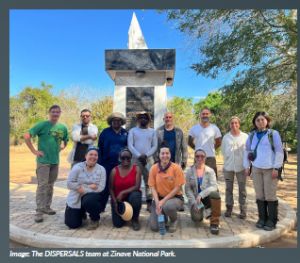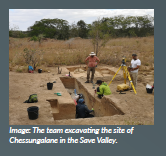The DISPERSALS project, led by Principal Investigator Nuno Bicho, is a landmark scientific initiative that seeks to understand the migration paths, resilience and adaptability of early Homo sapiens.
This research centres on the momentous dispersal of modern humans out of Africa, an epic migration that began approximately 70 000 years ago and paved the way for human presence across the globe. By examining the unique innovations and adaptive qualities that enabled these ancient humans to thrive amid ecological and environmental changes, DISPERSALS aims to shed light on the deeper processes that underlie human migration.
One of the project’s focal areas is central Mozambique, particularly the historically significant Limpopo and Save river basins, which serve as a vital corridor between southern and eastern Africa. This region offers valuable insights into early human movement, adaptation and population dynamics over the last 100 000 years. Through a multi-scale approach, the DISPERSALS project not only compares the cultural and ecological contexts of central Mozambique with other African regions but also investigates regional population patterns and diachronic shifts in human behaviour and adaptation.
DISPERSALS employs innovative methodologies such as GIS network analysis, agent-based modelling and comparative quantitative population genetics. These advanced techniques allow researchers to simulate the migration dynamics and reconstruct the intricate pathways and interactions that early human populations undertook. The integration of these diverse methods enables the team to visualise regional population patterns, explore ecological challenges faced by early humans and understand the strategic movements that led to successful dispersals beyond Africa.
By generating high-resolution archaeological, chronological and paleoenvironmental data, DISPERSALS is positioned to make significant contributions to our understanding of human evolution. This data will not only reveal the complex forces that shaped early human migrations but also provide a foundational perspective on the shared journey that connects all humans to this ancestral past. In doing so, DISPERSALS enriches our comprehension of early human history and illuminates the extraordinary resilience and adaptability that define the story of Homo sapiens.
The DISPERSALS team: a multidisciplinary approach to human history
The DISPERSALS team is an interdisciplinary and dynamic group of researchers and doctoral students combining expertise from a variety of scientific fields, united by their mission to decipher the complex migratory patterns of early Homo sapiens. Comprised of experts in archaeology, geology, biology and genetics, the team leverages a uniquely interdisciplinary approach to explore how humans interacted with, adapted to and traversed diverse environments across ancient landscapes. Experts in geoarchaeology, bioanthropology, radiocarbon dating, stable isotopes and ancient DNA research all bring vital perspectives, applying advanced methodologies like geophysical surveys, coastal geomorphology and GIS network analysis. This robust blend of disciplines facilitates a comprehensive reconstruction of human dispersal and enhances our understanding of how ecological changes and regional resources shaped early human resilience and adaptability. By interweaving archaeological, biological and geological insights, the DISPERSALS team delivers a multidimensional view of early human history, reconstructing the environmental and cultural landscapes that influenced our ancestors’ journeys.
DISPERSALS in the field
The DISPERSALS project, initiated in January 2023, has already seen significant progress through two primary field seasons, held each year in May and June, supported by smaller preparatory campaigns involving a four-person team.
The larger field teams, consisting of 15 to 20 members, include both experts and students from various institutions, including the Interdisciplinary Center for Archaeology and the Evolution of Human Behaviour (ICArEHB) at the Universidade do Algarve, Universidade Eduardo Mondlane, the University of Louisville and the University of Denver.
The objectives of these field campaigns are multifaceted, encompassing archaeological surveying, testing and excavation, along with the collection of a variety of samples. These samples include micromorphology, absolute dating, ancient DNA (aDNA), proteomics, biomarkers and current vegetation cover mapping. One of the key goals is the development of an isotope landscape map with a focus on Strontium isotopes. This map aims to provide a regional context that will be essential for understanding patterns of human mobility, particularly if human fossils are uncovered. Field surveys were conducted in several key regions in south-central Mozambique, including the inland area of Inhassoro in Inhambane Province, where the team searched for caves in limestone-rich territories. Additional surveys were undertaken in the Zinave National Park (also in Inhambane Province, south of the Save River), Coutada 5 (just north of the Save River), and the Inhaminga region in the Solafa district, located in the northern buffer zone of the Gorongoza National Park, where cave exploration was also a primary objective.
In these areas, the team covered hundreds of kilometres on foot, identifying over 140 Stone Age sites, including half a dozen caves. Numerous samples of vegetation and fauna were collected, particularly in the Save Valley, alongside water and sediment samples. These materials are being used to determine regional isotopic signatures and create detailed vegetation maps for the various study areas.
Among the most significant archaeological discoveries were the open-air sites of Zimuara and Chessungalane in the Save Valley, within Coutada 5. Extensive testing at these sites revealed valuable, long archaeological sequences, which are likely to date from the late Middle Stone Age to the transition to the Later Stone Age, roughly spanning between 80 000 and 20 000 years ago. A series of samples, including sediment for optically stimulated luminescence (OSL) dating and charcoal for radiocarbon dating, were collected, with results anticipated by 2025. Thousands of artefacts were also recovered from the excavations at Zimuara and Chessungalane, providing a substantial basis for further analysis.
For field data collection, the team utilised Ulefone Armor 22 smartphones to record survey paths and site locations and capture photographic documentation of each site. Additionally, a custom-developed app named ArchaeoSurvey was employed to streamline the archaeological survey process. During excavation activities, the team relied on two total stations and the ‘bucket method’ for 3D spatial recording of artefacts and samples, along with site mapping and stratigraphy recording, supported by photogrammetric techniques.
This ongoing work under the DISPERSALS project is expected to yield valuable insights into early human lifeways and migration in southern Africa, enhancing our understanding of human history in this region.
PROJECT SUMMARY
DISPERSALS will compare human occupation and ecology between central Mozambique and eastern and southern Africa using a multi-scale approach based on the study of regional diachronic cultural traits. It will reconstruct regional population patterns, followed by comparative quantitative population genetics combined with GIS computational network analyses.
The results will then be integrated through agent-based modelling, based on the incremental creation, elimination, or reorientation of network links to simulate a quantitative framework to study the evolution of population dispersal across southern-eastern Africa. The project will be crucial in providing ground-breaking high-resolution archaeological, chronological and paleoenvironmental data.
DISPERSALS will deliver a fundamental perspective on the key processes that triggered migrations and dispersals within Africa and out-of-Africa, which ultimately resulted in the human diaspora over the entire planet.
PROJECT LEAD
Professor Nuno Bicho received his PhD in Anthropology from Southern Methodist University, Dallas, Texas, in 1992. He is currently a Professor of Archaeology and the Vice-Rector for Research and Culture at the University of Algarve.
He is the Director of the PhD degree in Archaeology at the University of Algarve and was the founder and, until recently, Director of the ICArEHB (Interdisciplinary Center for Archaeology and Human Behavior). Together with Shannon McPherron, Bicho developed and was one of the Editors-in-Chief of the recent Journal of Paleolithic Archaeology (Springer-Nature Group).
He specialises in Palaeolithic ecodynamics, and his research has focused on prehistoric coastal hunter-gatherers of southern Iberia for the last three decades. More recently, he has also developed research on the Mesolithic of the Tagus Valley and the Stone Age of Mozambique and Sudan.
CONTACT DETAILS
Professor Nuno Bicho
ICArEHB, Campus de Gambelas, University of Algarve, 8005-139 Faro, PORTUGAL
Email: dispersals@icarehb.com
Web: https://dispersals.icarehb.com
X: @Dispersals_ERC
Instagram: @dispersals_erc
Facebook: /DispersalsERC
FUNDING
This project has received funding from the European Research Council (ERC) under the European Union’s Horizon 2020 research and innovation programme under grant agreement No. 101052761.
Images
Image: PI Nuno Bicho cleaning an exposed section at the site.
Image: Sampling snail shells for biomarkers to gain insights into environmental conditions in their habitats.
Image: Researchers Jonathan Haws and Nuno Bicho during fieldwork at the site.
Image: The DISPERSALS team at Zinave National Park.
Image: The team excavating the site of Chessungalane in the Save Valley.






